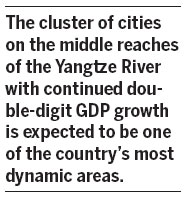| About Hubei | Culture & Arts | ||
| Attractions | Routes | ||
| Dining | Shopping | ||
| Hotels | Transportation | ||
| Entertainment | Travel agencies |
Jingshan to attract Wuhan tourists
Storytelling queen
For the love of Wuhan
Dangyang to promote tourism


Hubei sets sights on growth
By Rong Xiandong (China Daily)
Updated: 2013-03-12

Province to team up with neighbors to boost regional integration
Hubei province is aiming to build China's fourth economic growth area with three neighboring provinces. The move comes as expansion in the nation's three major economic growth centers slows amid sluggish international demand.
Hubei plans to strengthen regional economic integration with Hunan, Jiangxi and Anhui provinces, national legislators from the province said.
Wang Xiaodong, executive deputy governor of Hubei and a deputy to the 12th National People's Congress, called for the central government to adopt a national strategy, and urged joint efforts between the four provinces to promote regional cooperation to boost the slowing national economy as global economic gloom affects China's coastal areas.
The country's three major economic growth areas are the Pearl River Delta in Guangdong province, the Yangtze River Delta region relying on Shanghai municipality and Jiangsu and Zhejiang provinces, and the Bohai Sea rim region, including Beijing, Tianjin municipality and Hebei province.
Wang made the call on the sidelines of the ongoing NPC annual session.
The four provinces, in the middle reaches of the Yangtze River, have achieved substantial progress in areas including infrastructure, trade, investment, industrial transfer and agriculture, Wang said.
He said he hopes the provinces can make big breakthroughs in new modes of urban development, infrastructure network, industrial development, ecological development and market integration.
In February, the four provincial capital cities of Wuhan in Hubei, Changsha in Hunan, Nanchang in Jiangxi and Hefei in Anhui, signed a strategic cooperation framework agreement, a key step heralding comprehensive cooperation among the provinces.
NPC Deputy Tang Liangzhi, also mayor of Wuhan, said the cluster of cities on the middle reaches of the Yangtze with continued double-digit GDP growth is expected to be one of the country's most dynamic areas as slower growth in eastern coastal areas dragged down national economic growth to 7.8 percent in 2012.
Statistics show that in 2012 Wuhan, Changsha, Nanchang and Hefei achieved GDP growth of 11.4 percent, 13 percent, 12.5 percent and 13.6 percent, respectively.
Economist Gu Shengzu, vice-chairman of the NPC Financial and Economic Committee and former deputy governor of Hubei, said development of the cluster of cities will be characterized by transfers of the workforce and industry from eastern coastal areas to central and western areas.
Economic cooperation among the four provinces will help adjust the long-time regional imbalance, in which central and western areas are marginalized, Gu said.
Gu called for reform of administrative systems, and the removal of market barriers between the provinces to bring more tangible economic benefits.
The central government has attached great importance to the development of the cluster of cities, home to more than 10 percent of the country's population.
In late 2012, Vice-Premier Li Keqiang said development of the cluster, which grew to 40 cities from 29 after Anhui became part of it, needed to be accelerated as an important breakthrough in reducing a regional imbalance.
Zhang Ping, head of the National Development and Reform Commission, the top economic planning agency, told a news conference on the Chinese economy held on the sidelines of the ongoing NPC annual session on March 6, that the government will implement policies to help the four provinces use the advantages of the Yangtze River to promote development of the nation's central area.
Zhu Ning, an NPC deputy and general manager of China Changjiang National Shipping (Group) Corp, said shipping has obvious advantages in energy-saving and environmental development compared to road and rail transportation.
China has made ecological development part of its national strategy as it strives to transform its economy, which relies heavily on energy consumption.
rongxd@chinadaily.com.cn
(China Daily 03/12/2013 page8)